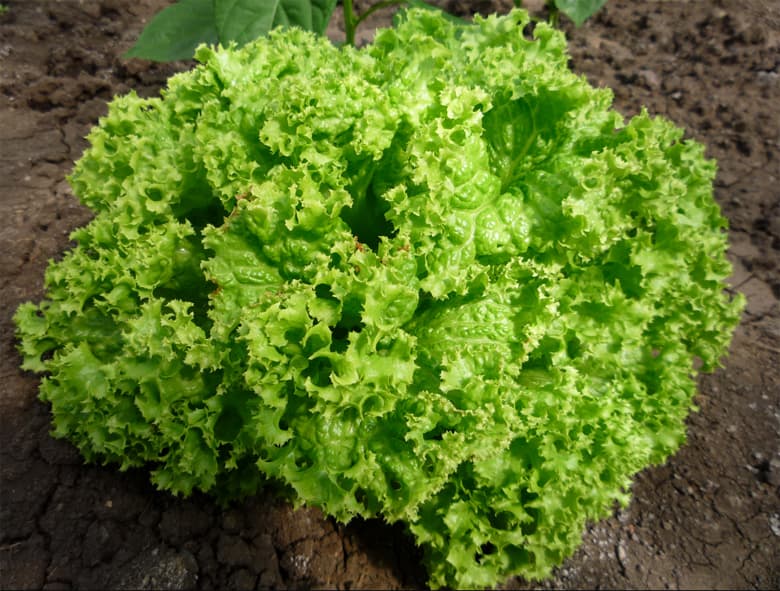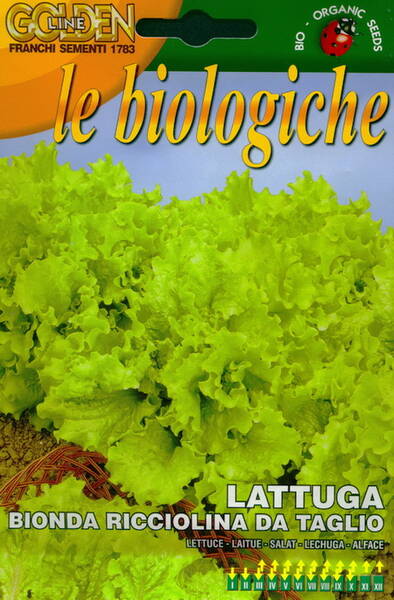The lettuce is early ripe, the crop can be harvested 40-45 days after germination. It has delicate, corrugated, very decorative green leaves.
Forms a loose head, 15-20 cm in diameter. The variety is resistant to bolting. Suitable for year-round cultivation in open ground and greenhouses.
Seeds have a positive reaction to light, that is, they germinate much faster in the light than in the dark.

* You can grow lettuce all year round: in winter - on a windowsill, in spring - on an insulated balcony or in a greenhouse, and in summer - in a vegetable garden.
It is well known that this plant is extremely useful. Lettuce leaves contain vitamins B1, B2, B6, PP, C, E, K, malic, citric, oxalic, succinic acids and carotene.
Healing and useful not only its leaves, but also seeds. It turns out that an infusion of lettuce seeds increases milk secretion in nursing mothers (take 1 tablespoon of seeds, grind them and pour boiling water. Infuse for half an hour and take 2 tablespoons 3 times a day).
The soil.
Soil with a good content of fertilizers is needed, since 80% of the lettuce roots are in the top layer, organic fertilizers (manure) are especially good. The soil should be rich in humus and not acidic, and should be kept moist throughout the lettuce growth period. Mid-season and late varieties are sown in a sunny or slightly shaded area. The soil is prepared in the fall, garden compost is added when digging. Shortly before sowing, the soil surface is broken with a rake until a finely lumpy structure is obtained and a complex mineral fertilizer is applied. In areas infected with soil pests, pyrimophosmethyl is applied. In areas with a warm climate, early varieties can be sown directly in open ground in a sunny, wind-sheltered place with well-drained soil.
Seeding and cultivation.
When growing seedlings, two seeds are sown in a peat pot (the weak plant is then removed). Before planting, the seedlings are hardened off. With direct sowing, the distance between rows is 35-40 cm, in a row 5-6 cm. The sowing depth is up to 1 cm (this method of sowing gives 380,000 plants per 1 ha). Next, a pick is needed. The frequency of watering depends on the soil, weather and level of development. From 0 to 30 cm, watering is 15-20 mm. Further, before the formation of a head, water less frequently, and more during the growth of the head.
It is good to grow salad after cucumber, potatoes, parsley and cabbage. It is possible to cover with a film to speed up the harvest, but this interferes with the creation of a stronger head of cabbage.
Care.
After the appearance of true leaves, seedlings are thinned out, thickening of crops should not be allowed. On the eve of thinning, the crops are watered. In the future, thin out in several stages until a distance of 15-30 cm remains between the plants (depending on the variety). Plants removed during thinning are planted without deepening the lower leaves into the soil. But it is better to sow lettuce immediately in a permanent place. Anti-slug granules are laid out around the crops, the crops are protected from birds. The soil around the plants is regularly loosened. Crops in open ground are watered abundantly, in protected ground - moderately. Greenhouses and greenhouses are aired as often as possible.
Harvesting.
Headed varieties are cut as soon as the middle of the head is formed. The degree of maturity is determined by lightly pressing on the top of the head of cabbage with the back of the hand. Do not squeeze the head of cabbage with your hands - this can damage the leaves. In overripe plants, the stem begins to lengthen. Such plants are immediately cut and used for food, and those that have begun to stem are thrown away.
Usually the lettuce is cut early in the morning before the dew has dried on it. Plants are uprooted, the root and lower leaves are cut off and disposed of in a compost heap.












